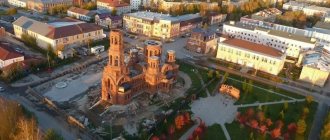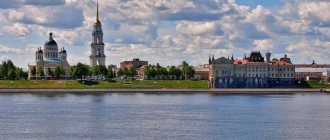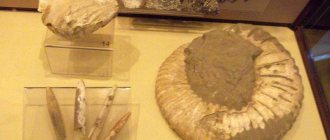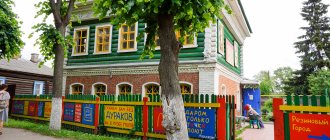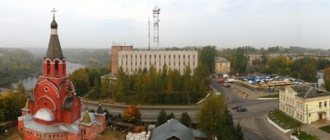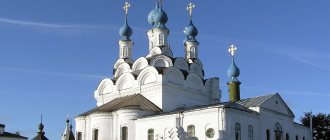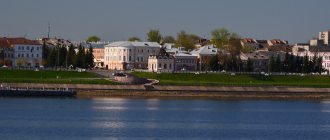The Rybinsk State Museum-Reserve, presenting exhibits of historical, architectural and artistic orientation, is the oldest museum complex in the city and is rightfully considered one of the most extensive in the entire Yaroslavl region. The year of foundation of the complex is considered to be 1910. It was during this period that the first natural science exhibition appeared on the territory of the settlement. Later, an art and history museum was also opened, and over time both institutions were merged into one.
Geographically, the museum-reserve is located on the city embankment. His exhibitions are conveniently located in the beautiful grain exchange building, the construction of which dates back to 1912. The author of the architectural masterpiece was A. Ivanov. For a long time, the majestic building was under the jurisdiction of various government organizations - a military hospital and headquarters, then a city hospital. It was decided to open a museum in the former grain exchange in 1992. But not only the exchange building belongs to the complex: it also includes part of the Flour Gostiny Dvor, built back in the 18th century.
Story
The Rybinsk Museum-Reserve was founded on October 17, 1910. At that time it was called the Natural Science Museum and consisted of five departments: mineralogy, zoology, botany, anthropology and geology. The total number of exhibits numbered several thousand.
In 1919, another museum was opened, an art historical museum, the collections of which were collected in noble estates, and also came from Moscow and Petrograd. In the 1930s, many employees were arrested on charges of promoting "remnants of antiquity." The most important exhibits were written off, but the nature department continued to be respected.
In the 50s of the 20th century, paintings by contemporary artists entered the museum’s collection, and the institution itself became a historical and artistic institution. Exhibitions of porcelain, icon painting, and folk art appeared.
In 1989, the museum received the status of a historical, artistic and architectural museum-reserve. Later, he was given the building of the new grain exchange, one of the decorations of Rybinsk .
0%
Let's get acquainted with the history of Rybinsk at the Rybinsk Museum-Reserve in the New Exchange building
The Rybinsk State Historical, Architectural and Art Museum-Reserve is located in the New Exchange building, which was erected by Moscow architect A.V. Ivanov in the pseudo-Russian style in 1912. Its collection is striking in its richness, which is more consistent, at least, with the regional center: a magnificent historical exhibition, an excellent art gallery.
Red Square and Rybinsk State Historical, Architectural and Art Museum-Reserve
This is largely explained both by the very wealth of Rybinsk in the past, and by the fact that part of the exhibition consisted of works of art from the flood zone of the Rybinsk reservoir, including a collection of art from the Musin-Pushkin estate. Of course, the enthusiasm of museum workers also played a huge role.
Museum staircase
The museum exhibition is divided into several sections: folk crafts and peasant life, the nature of the Rybinsk region, the history of Rybinsk. This is not a museum that can be explored on the run. Therefore, it is better to allocate at least a few hours to visit it.
♦ On topic: A short walk through the streets of Rybinsk
Museum exhibition dedicated to peasant life
Traditional life of the Rybinsk region
Traditional life of the Rybinsk region
Samovars and molds for printed gingerbread cookies
Molds for printed gingerbread cookies Reconstruction of a peasant hut
Peasant household utensils
Like any self-respecting local history museum, the museum has a section dedicated to the ancient history of the region. Here you can see mammoth tusks, bones of large fossil animals, and monuments of the Paleolithic and later eras.
Exposition dedicated to the ancient history of Rybinsk Exposition dedicated to the Paleolithic era
Tools of the ancient inhabitants of the Rybinsk region
Iron finds
Decorations
A small section is devoted to the nature of this region.
Lynx
Moving from hall to hall, you discover new facets of Rybinsk. The city, lying on ancient trade routes, could not help but develop. At least from the beginning of the 16th century, and perhaps earlier, the settlement belonged directly to the Moscow kings and provided the royal court with fish. Sterlet caught in these places was especially valued. This is where the name came from - Rybnaya Sloboda, which in 1777 received the status of a city and became known as Rybinsk.
Rybinsk in the Middle Ages
Thanks to its advantageous geographical location, Rybinsk grew rich. It was a transshipment point between the Upper and Middle Volga, as well as a junction point of an extensive network of waterways, including the Mariinsky water system (now the Volgo-Balt). In Rybinsk, goods from large ships that sailed along the Middle and Lower Volga were reloaded into small ships that could overcome the shallow waters of the Upper Volga. Rybinsk is rightly called the capital of barge haulers: during the summer navigation, a quarter of all Russian barge haulers passed through it
♦ On the topic: History of the Mariinsky water system (Volgo-Baltic Canal) and the Museum “Waterways of the North” in Vytegra
Rybinsk on river trade routes
Anchor
Map of the waterways of North-West Russia at the beginning of the 18th century
Exhibition dedicated to waterways
V.M. Maksimov. View of the city of Rybinsk. Sketch for the painting “The First Grain Caravan in Rybinsk”, 1886
The building of the New Exchange, which now houses the museum exhibition, has preserved its historical interiors. Looking at them, you realize how rich and important Rybinsk once was for the waterways of the European part of Russia.
Buildings of the Old and New Rybinsk Exchange Hall dedicated to Rybinsk of the 19th - early 20th centuries
Hall dedicated to Rybinsk of the 19th - early 20th centuries
Hall dedicated to Rybinsk of the 19th - early 20th centuries
Desk
Model of the tuer "Grand Duke Vladimir", 1888
Model of the Tikhvinka - the most popular vessel of the Tikhvin and Mariinsk water systems in the 19th century
Unjak
Exhibition dedicated to trade
Model of a steam engine, early 20th century
Krestovaya Street is the main street of Rybinsk, photo from the beginning of the 20th century Rybinsk theater Posters
The museum presents the interiors of residents of Rybinsk and its environs in the 19th and early 20th centuries.
Interior
Table and chairs
Buffet
Examples of typical interiors of houses of Rybinsk residents
Carved trim and door
Temporary exhibitions are also held at the museum-reserve. We went to an exhibition of ancient weapons.
Exhibition of ancient weapons
Exhibition of ancient weapons
Exhibition of ancient weapons
The time was approaching the closing of the museum. Therefore, we left the visit to the art gallery until the next morning: the museum employees said that we could go in with our ticket, we didn’t have to pay anything extra (we had a ticket for all the museum’s exhibitions). The collection of the Rybinsk Art Gallery includes more than 10,000 exhibits. Only after looking at its size, and then closer at some of the paintings, I understood why the day before the museum workers advised us to come here in the morning and not look at it on the run.
Art gallery hall
The hall of the Rybinsk Art Gallery is very beautiful - large and bright.
Art gallery hall
Unique works of painting from the collections of the Musins-Pushkins and other noble families of the Rybinsk region are presented here.
Collection of paintings from the 18th century
Old piano
Peter I interrogates Tsarevich Alexei Petrovich in Peterhof. Nikolay Ge, author's copy
Pine on the sand. Ivan Shishkin, 1884 (?)
Sleeping. Kuznetsov N.D., 1893
Self-portrait with daughters. Zinaida Serebryakova, 1921
Painting of the 20-30s of the XX century
The Rybinsk Museum-Reserve houses a rich collection of icons from destroyed churches.
Collection of icons of the Savior Not Made by Hands. Last quarter of the 16th century. From the Peter and Paul Church of the Petrovskoye estate
Our Lady of Kykkos, 1693
Shroud
The second tier of the gallery displays paintings and home furnishings from estates that fell into the flood zone of the Rybinsk Reservoir.
Portraits
Hall with portraits Harp
Art Gallery
New Exchange building and Volga
I highly recommend visiting this museum when you are in Rybinsk. You will not regret!
Information for visitors
- Address of the Rybinsk State Historical, Architectural and Art Museum-Reserve: Volzhskaya embankment, 2, Tsentralny district, Tsentralny microdistrict, Rybinsk
- Opening hours: Monday to Friday from 9:00 to 17:00, Saturday, Sunday and holidays from 10:00 to 18:00
- Phones (order excursions), +7 (4855) 28-39-94 (administrator), (reception), +7 (4855) 28-38-89 (fax)
- Website: www.rybmuseum.ru
© Website “On the Roads of the Middle Way”, 2009-2021. Copying and reprinting of any materials and photographs from the site anashina.com in electronic publications and printed publications is prohibited.
Permanent exhibitions
The exhibition department of the museum includes two sectors: historical and artistic. Main permanent exhibitions:
- History of the museum.
- The nature of the region, where stuffed representatives of the animal world living in the region are presented.
- A zoological exhibition that gives the visitor the opportunity to get acquainted with live birds and animals.
- The most ancient past of the region.
- Training class "Burlage"
There are also collections of rare books, numismatics, and decorative and applied arts.

